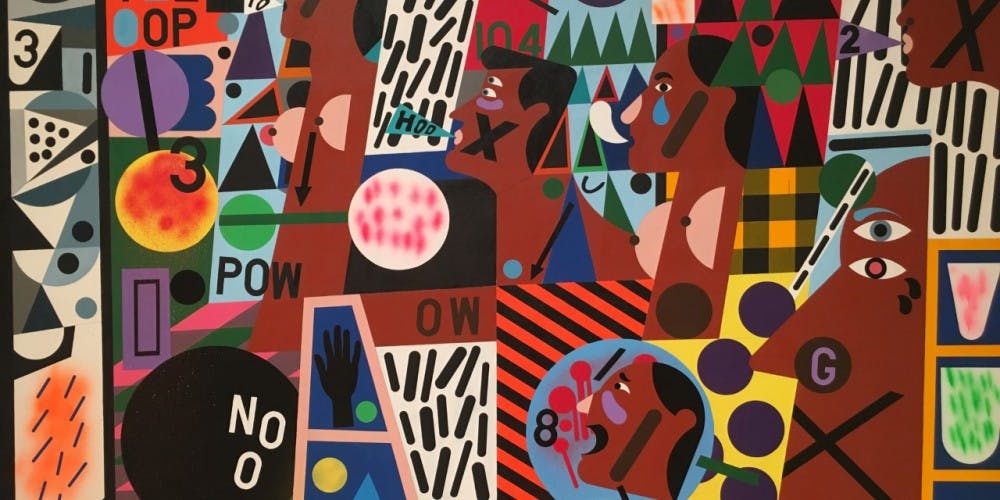The crowd at the Nasher Museum of Art last Thursday was bustling and spirited, a diverse commingling of students and residents from the farthest reaches of the Triangle area. Exhausted parents chased restless children through the lobby, snippets of conversations about art and politics floated freely above the fringe and people milled about the hallways of art, stopping frequently to snap pictures and ponder them silently. The droves of people were there to partake in the opening party for “Royal Flush,” an exhibition of artist Nina Chanel Abney’s work over the last ten years.
Abney, who is 34 years old and hails from Chicago, Illinois, creates art that should make you feel uncomfortable–her commentaries on race, sex, religion and sexuality eschew conventional modes of storytelling in art that we’ve become accustomed to. Instead, Abney opts to bombard the viewer from the outset with images, words, numbers and colors that have been collaged in a manner that’s both coherent and overwhelming. Her work stems from an era wherein information is disseminated across smartphone screens and news cycles with unrelenting fervor, the incessant barrage of information a clear inspiration for both the style and content of her art. Marwa Yusuf, a Ph.D. student at UNC-Chapel Hill who was in attendance at the opening party, noted the forcefulness of Abney’s style.
“What drew me to her work–I hadn’t heard of her before coming [to the event]–is definitely the themes, but also the colors,” she said. “There’s something about the colors that’s just so bold, but in a way that’s not boldness for boldness’s sake. There’s a coherence with the theme.”
While Abney’s artwork may be frantic and busy, her intentions are clear–whether it’s by painting a police officer with the word “OINK” adorned on his chest or depicting former secretary of state Condoleezza Rice as part of a famous celebrity couple, Abney ensures that the viewer will be forced to engage with themes ranging from police brutality, the objectification of women’s bodies and the prevalence of celebrity culture. And in a millennium where unarmed black men are killed by law enforcement daily and treating women like second-class citizens doesn’t bar you from the presidency, Abney’s criticisms are more than significant and relevant–they are unavoidable.
“These [pieces] are all very dense, and I think that [Abney] communicated in a way that’s not subtle,” Yusuf said. “I think that’s how it should be–at least our conversation about these topics needs to be out loud and clear.”
Tackling such upsetting and moving subject matters doesn’t have to be a dismal affair, though–Abney is wickedly sharp, her sense of humor woven seamlessly into the pieces and often belying the seriousness of what she’s depicting. But humor is a weapon that can be wielded to make traumatic events more emotionally accessible, as noted by UNC-Chapel Hill Ph.D. student Katie Merriman, who attended the opening party with Yusuf.
“I think her use of farce is really helpful, because often times trying to overlay a sense of seriousness about an event that involves violence takes away from the ability to talk about the emotional and the psychological impact of such an event,” Merriman said. “To kind of throwback at people who just want to talk about information and numbers and instead say, ‘How could this happen?’”
“When we think about things that are political, this is not how we think about them,” Yusuf added. “But there are desires, there is humor, there are all of these social practices that sometimes get ignored when we talk about politics. So it broadens the scope of what is political and what’s not.”
To categorize Abney’s work as merely protest art or another form of activism for Black Lives Matter is to diminish the ambitious portfolio that she’s carefully curated. Abney’s art is a visceral celebration of blackness and identity that’s both critical and joyous, proof of the nuanced beauty that can arise in response to systemic oppression. The bright, irreverent canvases draw you in with their chaos, humor and shocking images, but when you pull back, Abney’s voice seems to say: I am black, I am proud and I am powerful.
Reflective of this recognition of blackness and black culture were the festivities that occurred during the opening party, emceed by Durham resident, NCCU and UNC-CH professor and musician Pierce Freelon. The performances included Duke student saxophonist Edgeri Hudlin, poets from Freelon’s Afro-futurist makerspace for black youth called Blackspace and Duke student and spoken word artist Ashley Croker-Benn.
Any music played was made by black musicians and any poem performed dealt with black identity, all in the presence of Abney’s paintings, encircled by the difficulties and victories that accompany being black in America. It was an emotional outpouring of identity and culture that complimented Abney’s work well, an urgent reminder that compassion for others and a yearning for change are essential.
Nina Chanel Abney’s “Royal Flush” will be on display at the Nasher Museum of Art until July 16. The exhibition is a 10-year survey of approximately 30 of the artist’s paintings, watercolors and collages.
Get The Chronicle straight to your inbox
Signup for our weekly newsletter. Cancel at any time.

